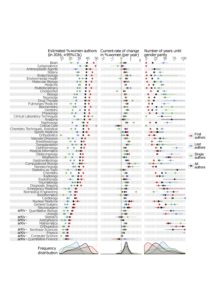Women in STEMM: Will the gender gap close in your lifetime? (PLOS Biol)
 Gender inequality has been a much-discussed topic in recent years, and many studies on gender inequality relating to employment, business success, and opportunities for education have recently been published. Academia is no different, and gender inequality is still a major concern in the Science, Technology, Engineering, Mathematics and Medicine (STEMM) fields. Although many agree that the gender gap is smaller today than in the past, quantifying the gap and calculating the rate of change across disciplines have not been done, until a recent study by Holman et al. The study investigated the number of men and women authors of more than 10 million academic publications, their positions (first, middle, last or single author) and predicted how long, if ever, it will take to reach gender parity. Some of their results were concerning; many major research-producing, wealthy countries, such as Japan, Germany and Switzerland, displayed pronounced STEMM gender inequality; certain male-biased disciplines, such as physics, surgery, computer science and mathematics, displayed a persistent gender gap that will not reach parity in the next 100 years, if at all; and women are far less likely to be commissioned to write papers, submit to and publish in high-impact journals, or be invited keynote speakers at conferences. Although the study did highlight some positives (more gender equality across Europe, South America and Africa, and a general trend towards gender parity across most disciplines) efforts must be focused on recruiting and retaining women researchers across disciplines, reforming the academic publishing and peer review system, and improving support for demands outside the workplace. These interventions may decrease the time to gender parity across STEMM fields. See https://lukeholman.github.io/genderGap/ for a web app allowing easy access to the data used in this study. (Summary by Danielle Roodt Prinsloo) PLOS Biol. 10.1371/journal.pbio.2004956
Gender inequality has been a much-discussed topic in recent years, and many studies on gender inequality relating to employment, business success, and opportunities for education have recently been published. Academia is no different, and gender inequality is still a major concern in the Science, Technology, Engineering, Mathematics and Medicine (STEMM) fields. Although many agree that the gender gap is smaller today than in the past, quantifying the gap and calculating the rate of change across disciplines have not been done, until a recent study by Holman et al. The study investigated the number of men and women authors of more than 10 million academic publications, their positions (first, middle, last or single author) and predicted how long, if ever, it will take to reach gender parity. Some of their results were concerning; many major research-producing, wealthy countries, such as Japan, Germany and Switzerland, displayed pronounced STEMM gender inequality; certain male-biased disciplines, such as physics, surgery, computer science and mathematics, displayed a persistent gender gap that will not reach parity in the next 100 years, if at all; and women are far less likely to be commissioned to write papers, submit to and publish in high-impact journals, or be invited keynote speakers at conferences. Although the study did highlight some positives (more gender equality across Europe, South America and Africa, and a general trend towards gender parity across most disciplines) efforts must be focused on recruiting and retaining women researchers across disciplines, reforming the academic publishing and peer review system, and improving support for demands outside the workplace. These interventions may decrease the time to gender parity across STEMM fields. See https://lukeholman.github.io/genderGap/ for a web app allowing easy access to the data used in this study. (Summary by Danielle Roodt Prinsloo) PLOS Biol. 10.1371/journal.pbio.2004956



